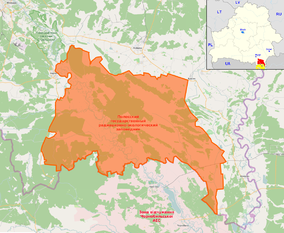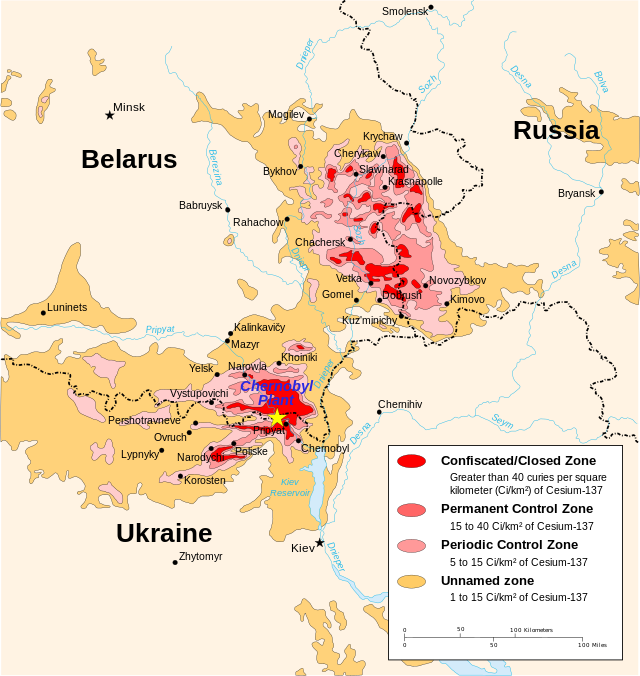Polesie State Radioecological Reserve
Nature reserve in Belarus From Wikipedia, the free encyclopedia
Nature reserve in Belarus From Wikipedia, the free encyclopedia
The Polesie State Radioecological Reserve (PSRER; Belarusian: Палескі дзяржаўны радыяцыйна-экалагічны запаведнік, romanized: Palyeski dzyarzhawny radyyatsyyna-ekalahichny zapavyednik; Russian: Полесский государственный радиационно-экологический заповедник, romanized: Polessky gosudarstvenny radiatsionno-ekologichesky zapovednik) is a radioecological nature reserve in the Polesie region of Belarus, which was created to enclose the territory of Belarus most affected by radioactive fallout from the Chernobyl disaster. The reserve adjoins the Chernobyl Exclusion Zone in Ukraine. The environmental monitoring and countermeasure agency, Bellesrad, oversees the agriculture and forestry in the area.
This article includes a list of general references, but it lacks sufficient corresponding inline citations. (June 2014) |
| Polesie State Radioecological Reserve | |
|---|---|
| Палескі дзяржаўны радыяцыйна-экалагічны запаведнік (Belarusian) Полесский государственный радиационно-экологический заповедник (Russian) | |
 OSM map of the reserve highlighting some nearby places in the annotations (as Mazyr, Pripyat, the Chernobyl Plant etc). The map in the corner shows its position (red) within Belarus, showing also the Ukrainian, and contiguous, Chernobyl Exclusion Zone (yellow) | |
 | |
| Location | Belarus |
| Nearest city | Brahin, Narowlya, Khoiniki |
| Coordinates | 51°39′N 29°59′E |
| Area | 2,162 km2 (835 sq mi) |
| Established | July 18, 1988[1] |
| Official website | |

Two years after the Chernobyl disaster, the Belarusian part of the Chernobyl Exclusion Zone was extended to a more highly contaminated area. Then, a closed-to-the-public nature reserve was established in Belarus with a total area of 1,313 km2 (507 sq mi). The reserve was established on July 18, 1988.[1] Before the disaster, over 22,000 people lived there in 96 settlements. The population was evacuated after the disaster. In 1993 it was expanded by 849 km2 (328 sq mi), making it the largest Belarusian nature reserve and one of the largest in Europe.
The area, located in southern Gomel Region and bordering the Ukrainian Exclusion Zone, includes part of the raions (districts) of Brahin, Khoiniki and Narowlya.[2] It is crossed by the Pripyat River, and the city of Mazyr is 36 km (22 mi) from the northwestern entrance, in Narowlya. The southern strip is crossed by the Chernihiv–Ovruch railway, which passes through the villages of Kaporanka, Kalyban and Pasudava.
The following list shows the abandoned villages included in the reserve. Population refers to the 1959 census. "fam." refers to the number of families evacuated after the 1986 disaster.
| Settlement |
Pop. (1959) |
Fam. (1986) |
District | Belarusian | Russian |
|---|---|---|---|---|---|
| Aravichy | 923 |
222 |
Khoiniki | Аравічы | Оревичи |
| Babchyn | 839 |
194 |
Khoiniki | Бабчын | Бабчин |
| Bagushi | 599 |
195 |
Brahin | Багушы | Богуши |
| Buda | 267 |
56 |
Khoiniki | Буда | Буда |
| Chamkou | 138 |
29 |
Khoiniki | Чамкоў | Чемков |
| Dzernavichy | 1,016 |
308 |
Narowlya | Дзёрнавічы | Дёрновичи |
| Haroshkau | 191 |
154 |
Khoiniki | Гарошкаў | Горошков |
| Kalyban | 977 |
270 |
Brahin | Калыбань | Колыбань |
| Kaporanka | 317 |
70 |
Brahin | Капоранка | Капоренка |
| Kazhushki | 869 |
214 |
Khoiniki | Кажушкі | Кожушки |
| Lomachy | 177 |
38 |
Khoiniki | Ломачы | Ломачи |
| Novakukhnaushchyna | 135 |
13 |
Khoiniki | Новакухнаўшчына | Новокухновщина |
| Novy Pakrousk | 176 |
29 |
Khoiniki | Новы Пакроўск | Новый Покровск |
| Pasudava | 642 |
73 |
Brahin | Пасудава | Посудово |
| Pirki | 552 |
476 |
Brahin | Піркі | Пирки |
| Rudyya | 245 |
40 |
Khoiniki | Рудыя | Рудые |

The reserve hosts many rare and endangered species, which thrive there thanks to the virtual absence of humans. They include European bison, Przewalski horse, moose, brown bear, golden eagle, and white-tailed eagle. It is home to the world's largest population of the European pond turtle. According to PSRER administration, there are 7 reptile, 11 amphibian, 46 mammal, 213 bird and 25 fish species. Of those, 70 are listed in the International Red Book and the Red Book of the Republic of Belarus. Flora includes 1251 registered plants, which is more than two-thirds of the flora of the country, and 18 of the plant species are listed in the Red Book.[3] It was found that voles have higher rates of cataracts, useful populations of bacteria on the wings of birds in the zone are lower, partial albinism is common among barn swallows, and cuckoos have become less common. Serious animal mutations, though, happened only right after the accident.[4]
Although the reserve was established for the purpose of radiobiological and environmental research, it is of interest to other biologists. Due to the minimal human presence, it is possible to observe the natural development of wildlife in the conditions of Belarus. "In connection with the removal of anthropogenic load and the wealth of flora the ideal conditions for the recovery of the animal world have been created here", states the report of the Committee on the Health Effects of the Chernobyl disaster at the Council of Ministers of Belarus. Some new species, including European bison, have been introduced on the territory of the reserve.
Administration of PSRER is located in the town of Khoiniki. The annual budget of PSRER is 4 million USD. Main activities include:[5]
The administration uses land in the reserve to earn income in addition to its budget. The purpose is to increase the self-sufficiency of the reserve, save money, increase the salaries of employees and contribute positively to the GDP of Belarus. Activities include:
As of 2004, the herd at the reserve's horse farm numbered 230 horses. Cattle are being bred to endure the conditions of radioactive contamination, and young individuals are sold for further breeding.
During all activities, radionuclide concentrations are monitored to ensure they do not exceed certain limits.[6]
As of 2024, besides the Polesie State Radioecological Reserve bordering Ukraine, there are also closed areas in Belarus along the Russian border, located east and north of the city of Vetka. These zones are situated in the eastern part of the Gomel region and the southeastern part of the Mogilev region, south of the city of Cherykaw. Signboards mark the boundaries of the area and indicate radiation exposure. Entry to the area is permitted only with permission from the authorities.
Seamless Wikipedia browsing. On steroids.
Every time you click a link to Wikipedia, Wiktionary or Wikiquote in your browser's search results, it will show the modern Wikiwand interface.
Wikiwand extension is a five stars, simple, with minimum permission required to keep your browsing private, safe and transparent.